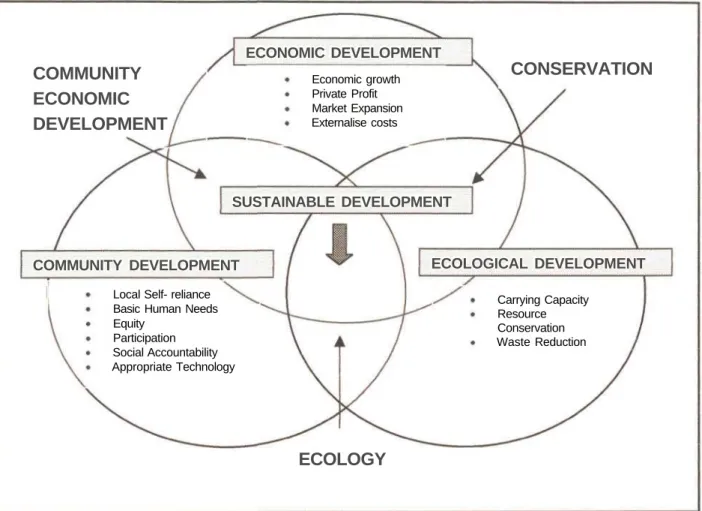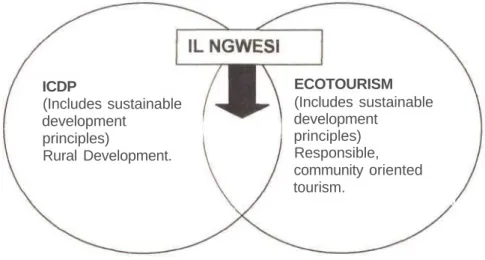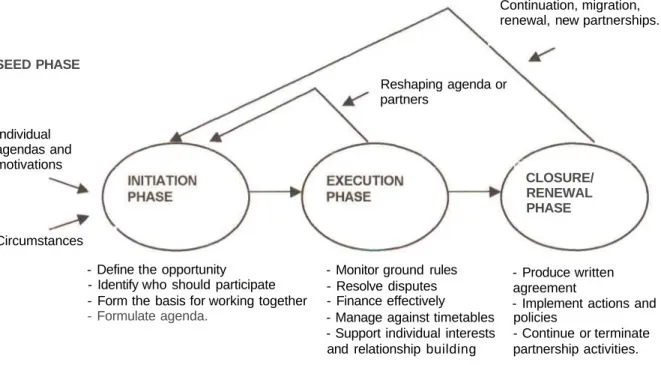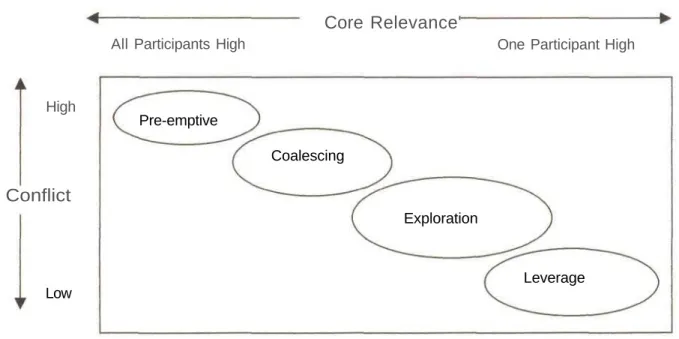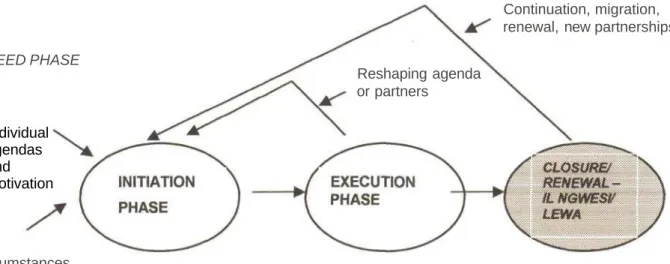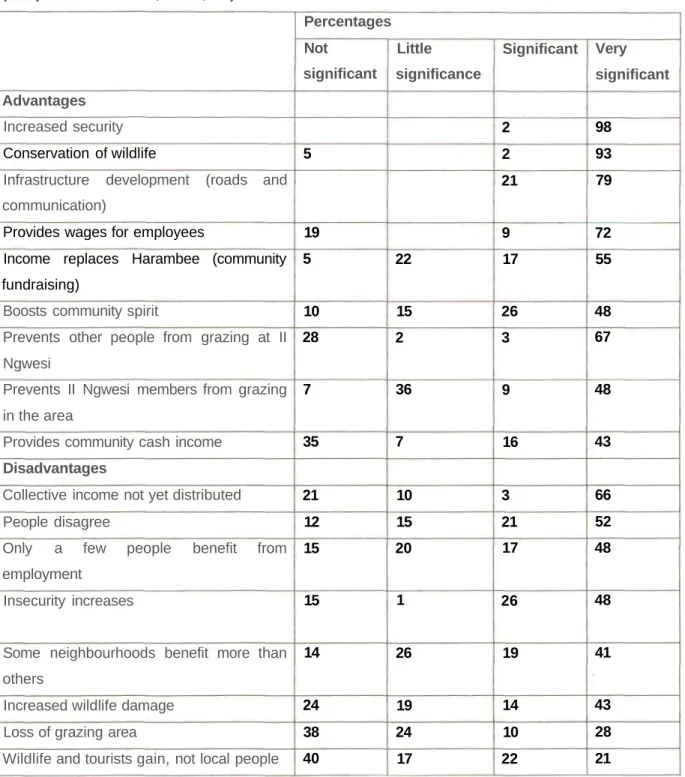Partnership Map (Long and Arnold, 1995) 50 Fig 4.2 II Ngwesi/Lewa Partnership in the Partnership Life Cycle 54 Fig 5.1: II Ngwesi Environmental Partnership Diagram 85 Fig 5.2: Community Conservation Partnership Model 88. Chapter 1 explores the concepts behind ICDPs and ecotourism thinking , before introducing environmental partnership theory as a tool to analyze the partnership-based ICDP/ecotourism project at II Ngwesi. The analysis combines these key aspects to create a graphic record of the partnering process at II Ngwesi.
At the end of chapter six, recommendations are made for improvements that can be made to the II Ngwesi project. The research therefore moves from the theoretical and/or conceptual basis of understanding to qualitative data collection techniques that represent the lived reality of the case study and the nature of the partnership at II Ngwesi, and back again.
LITERATURE REVIEW AND THEORETICAL FRAMEWORK
First, it examines the concept of sustainable development and how it emerged from the environmental movement. Interpretations of the environment fall into two broad categories, namely the anthropocentric and the bioethical. The future refers both to human capital and to the natural integrity of the area, and this must be done.
Ecological integrity refers to the healthy functioning of natural systems (eg rivers, air, soil and marine integrity). The current study attempts to answer these questions in the context of the II Ngwesi Community Tourism Project.
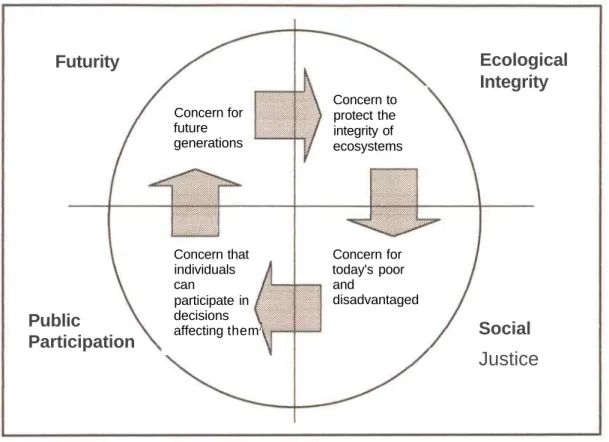
BACKGROUND TO THE STUDY AREA
II Ngwesi is located in northern Kenya, in the Mukogodo Division of Laikipia District, just north of the Laikipia Plateau (see Figure 2.1). The topography of the II Ngwesi group's ranch ranges from 1,800 meters above sea level in the highlands to 1,600 meters in the lowlands. It also cut off Maasai pastoralists from the best grazing lands in the Rift Valley.
The people are historically part of Ndorobo and even the very name II Ngwesi means wild animal in OlMaa (per message. Due to the legal implications, the relationship between people and wild animals became extremely strained. A partnership was formed and the initial result was the opening of II Ngwesi Lodge in 1996.
All gangs have been built to take advantage of the endless views of the area. The aim of the stakeholder analysis is to understand who are the beneficiaries behind the environmental partnership at II Ngwesa. Compared to the majority of group ranchers, these four overlapping groups have a larger stake in the management and running of the lodge.
Dyer is now committed to the development of the area and contributes his time and resources with Ian Craig, including sitting on the II Ngwesi Lodge Board of Directors. These members make all the decisions about the future of the Lodge and are an autonomous entity. All the decisions regarding the activities of the CA are based on consensus and transparency.
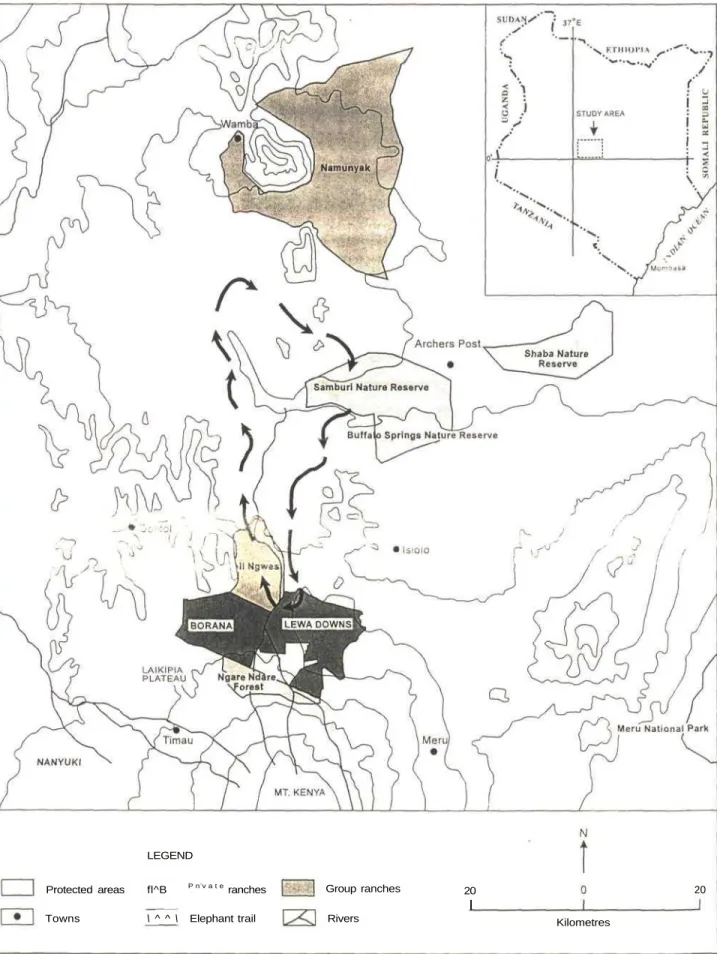
METHODOLOGY
Methodological Tools
Comprehensive research is concerned with discovering some of the common characteristics and general patterns common to a population as a whole. The intensive form was chosen because of the need to focus on the causal processes in the case of II Ngwesi. This was very suitable as it allowed the researcher to select individuals as the research progressed and as an understanding of the membership of a causal group unfolded and was built.
The nature of the inquiry allowed for unlimited collection of information about the partnership process. One of the clear advantages of this form of inquiry was that the respondents could raise questions that the researcher might not have anticipated, giving a 'deeper' picture than the questionnaire survey (Silverman, 1993; 15). This meant that the researcher would physically travel to these places, which also gave an insight into the conditions in the places where the respondents were located.
This study also aims to fulfill the role of an extension of the AWF study. The researcher is of the opinion that the investigation together with statistical surveys and quantitative analysis of the AWF report can be used as a complimentary method to understand the partnership processes at II Ngwesi. However, it was felt that the combination of the interviews and participant observation would overcome some of the inconsistencies.
It was a challenge for the researcher to remain objective, as spending time at II Ngwesa meant being immersed in the daily trials and joys of the people and the place. Because of this, the researcher sought out people who did not benefit from the project to create a balanced view of the partnership. It was necessary to recognize the dynamic social interaction between the interviewer and the subject.
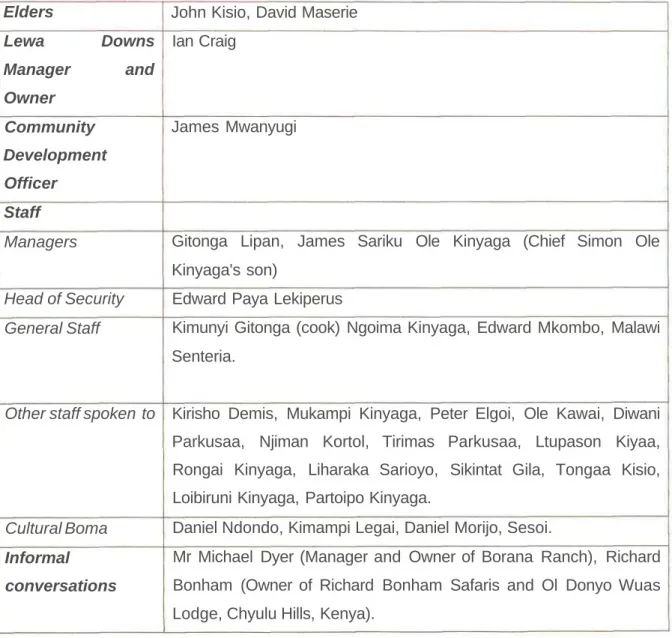
DATA ANALYSIS
The outcome of these combined efforts was the concept of the II Ngwesi ICDP/ecotourism lodge (introduced in Chapter Two). This section locates II Ngwesi in terms of the 'partnership typology' proposed by Long and Arnold (1995) and discussed in Chapter One. As already noted, the central environmental issue at II Ngwesi was that of wider ecosystem management.
In the case of the II Ngwesi/Lewa partnership, much has been achieved in a short time. In terms of classifying the current status of the partnership, the Partnership Life Cycle (PLC) should be consulted. The report argues that the community linked the improvements in livelihoods to the fortunes of the wildlife and the Lodge.
The PALI survey showed that the community feels the advantages and disadvantages of the Lodge. This is one of the most important issues regarding the opportunities for the success of the partnership. The positive gains at II Ngwesi have already had an effect on the attitudes of the other communities in the region.
According to the theory, the complete change of attitude is necessary otherwise it can be a limitation for the success of the partnership in the long term (Long and Arnold, 1995). Another important benefit of the partnership is the security it has brought to the area. The first, in relation to the members of the partnership and the balance of power that exists between them.
A key question of the II Ngwesi/Lewa partnership is that expertise is a resident, permanent part of the project. However, this issue is critical to the success of the partnership and should be included.
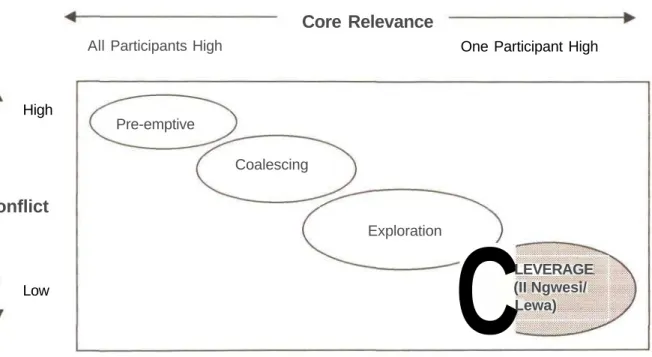
DISCUSSION AND MODEL GENERATION
Model Generation
By combining the partnership evolution and analysis section with a discussion of benefits and partnership characteristics, a rough guide to the successful implementation of the community conservation partnership at II Ngwesi emerges in the form of a diagram. The diagram graphically shows the environmental partnership life cycle of the II Ngwesi/Lewa project to date, with the shaded boxes showing the opportunities for the success of the partnership. During the seeding phase, the circumstances of the individual participants are shown in the large circles.
This led to the partnership proper, but with the addition of the essential ingredients of donor funding from USAID, COBRA etc., and strong leadership in the form of Ian Craig and Simon Ole Kinyaga. With the addition of the essential principles of ecotourism, the conservation area was established and the II Ngwesi Lodge built. Furthermore, community attitudes towards nature have changed as development is seen in the form of security, livelihood improvements, empowerment and strengthening of GR institutions, and overall GR development.
The model presented here provides a graphic illustration of the essential ingredients needed for a healthy community conservation-environment partnership, whose goal is to achieve wildlife and biodiversity conservation while providing for community development. The more powerful partner should ideally demonstrate a proven commitment to developing the partnership which is environmentally sustainable and will create sustainable community benefits. The community must have a structure that represents the interests of all members of the community.
The functions of a community partner are: securing land, managing community interests, dispersing funds generated by the tourism enterprise for development projects, obtaining community input for development, and utilizing area and animal expertise. A key concept of the model is the inclusion of the community at the top of management and development structures and not merely as a symbolic partner or limited beneficiary. The closure/reconstruction phase will include a review of the process and an assessment of direct and indirect benefits.
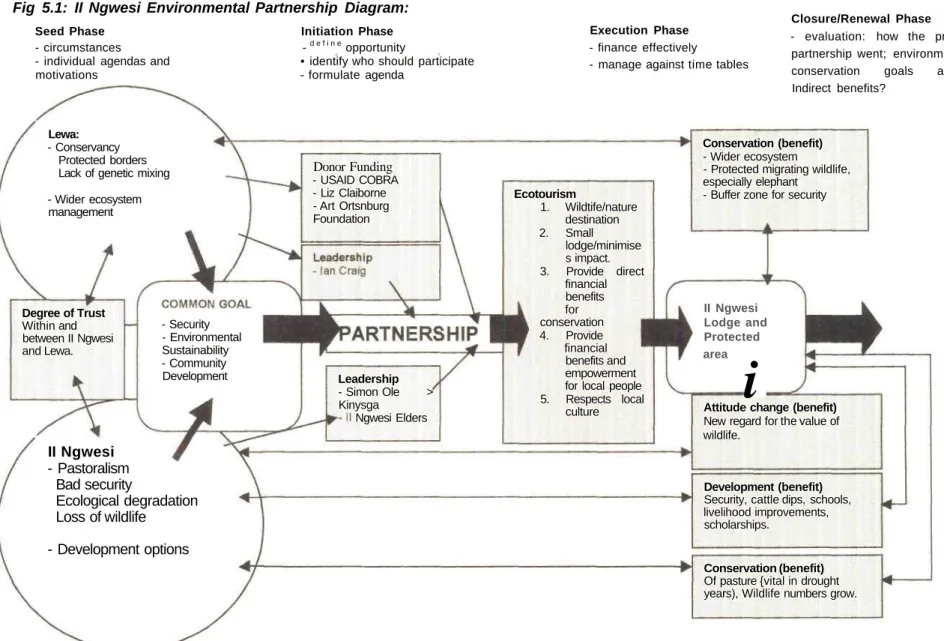
CONCLUSION AND RECOMMENDATIONS FOR IL NGWESI
- Staff Training
- Inclusion of Women
- Donor Funding
- Tourist Questionnaire
Despite the successes of the II Ngwesi/Lewa Downs environmental partnership, there are several issues that this study identified that need to be addressed to further improve the project. The empowerment of the local people is the essential element to community preservation and therefore human resources must be strengthened through capacity building and improvement of education. Strengthening the organizational capacities of the local II Ngwesi institutions is of critical importance for effective management and control of projects and resource use.
Some believe that the design, financing and management of such projects should be the domain of the community alone. A critical analysis of the program (IIED, 1994) reported that the program was marked by successes as well as failures. The Kenyan government promised social benefits to the Maasai from the establishment of a park that included a water system until the drought.
However, government budget cuts prevented necessary repairs to the pipeline, resulting in a system failure and a return of the Maasai and their livestock to the park. In contrast to the situation in most of the rest of Kenya, elephant and rhino numbers increased. How important is strong and honest leadership for the success of the project, and what does that leadership actually look like?
Are less powerful groups (eg women) enabled to play a more participatory role in the day-to-day management of the project. Is this project 'true ecotourism' or 'ecotourism lite', and how does this relate to the nature of the partnership involved in this case. What is the likely future of the project, given the nature of the partnership on which it rests.
